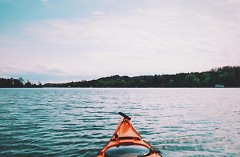The city of Grand Rapids owes its name to the Grand River’s once-iconic whitewater rapids—although they have been absent for so long that no one alive today has seen the river in its unaltered state. Now, plans are trickling forward to restore the Grand River’s whitewater. The idea from evolved from Grand Rapids WhiteWater and the Green Grand Rapids Master plan, adopted in November 2011.
Two years later, Grand Rapids WhiteWater released the preliminary Grand River Restoration Plan, which aimed to remove dams, reintroduce boulder rapids below the sixth Street dam, and construct a sea lamprey barrier.
The restoration project represents a significant enterprise—but the effort is not merely for the city’s name’s sake. Reintroducing the rapids is projected to restore lake sturgeon and other native fish spawning grounds, improve local recreation opportunities, and encourage cash flow from recreation tourism as visitors stream to the city for kayaking and fishing excursions. If the river flows freely, the argument goes, so will the tourism dollars.
The economic benefits were documented in the 2014 Grand Rapids Whitewater Economic Impact Study which projects that restoring the rapids will produce a net economic result of between $15.9 and $19.1 million annually.
“The results of this study are a local reflection of what we have seen throughout the Great Lakes Region,” Todd Ambs, the campaign director of Healing Our Waters-Great Lakes Coalition told Grand Rapids WhiteWater. The Coalition and the Brookings Institute found in 2007 that every dollar invested in restoration of the Great Lakes region resulted in at least twice that in economic returns.
Aspects of River Restoration have been incorporated into the GR Forward Initiative. Started in April 2014, the Initiative seeks to reimagine, alter, and ultimately improve the river in terms of its flood resilience, native species habitat, and opportunities for human recreation. The plan encompasses the surrounding neighborhoods and proposes green spaces as well, with the intention of revitalizing riverfront communities as well as the river.
Restoration of the rapids is a key focus of the city’s Grand River Corridor Revitalization Committee—in fact, construction of the rapids could begin as soon as 2017, according to Jay Steffan, Grand Rapids’ assistant planning director. “But,” he cautioned MLive’s Matt Vande Bunte last summer, “there are a whole lot of ifs, ands, or buts with that scenario.”
Perhaps the most significant “if” is the city’s quest for funding—the project’s scope is significant, spanning the river corridor from Lamoreaux to Millennium Parks. The Committee’s co-chair, Joe Jones, was determined funding opportunities exist. Last July he told Vande Bunte, “we will leave no stone unturned in an effort to find the resources.”
The Rapidian, a program of the 501(c)3 nonprofit Community Media Center, relies on the community’s support to help cover the cost of training reporters and publishing content.
We need your help.
If each of our readers and content creators who values this community platform help support its creation and maintenance, The Rapidian can continue to educate and facilitate a conversation around issues for years to come.
Please support The Rapidian and make a contribution today.
Comments, like all content, are held to The Rapidian standards of civility and open identity as outlined in our Terms of Use and Values Statement. We reserve the right to remove any content that does not hold to these standards.
